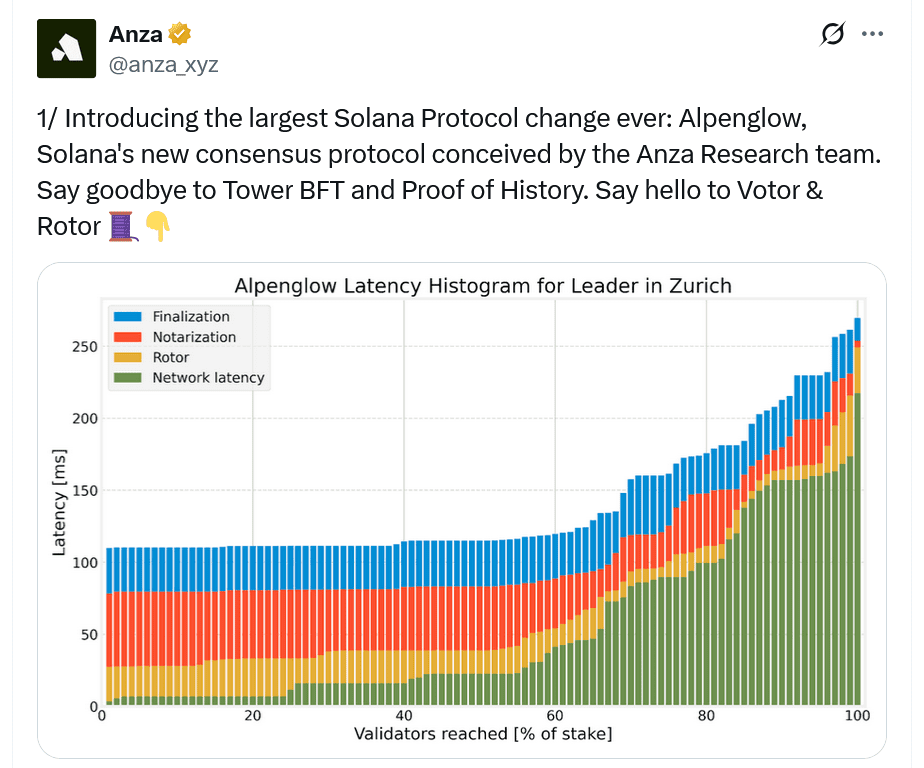Anza, an infrastructure firm originating from Solana Labs, has unveiled Alpenglow, a groundbreaking proof-of-stake (PoS) consensus protocol poised to revolutionize the Solana blockchain. Anza claims Alpenglow represents the most significant modification to Solana’s core protocol to date, potentially enabling the network to achieve speeds comparable to traditional internet infrastructure.
According to Anza’s Quentin Kniep, Kobi Sliwinski, and Roger Wattenhofer, “The release of Alpenglow will be a turning point for Solana. Alpenglow is not only a new consensus protocol, but the biggest change to Solana’s core protocol since, well, ever.”
Alpenglow consists of two core components: Votor and Rotor.
- Votor: Processes voting transactions and manages block finalization logic, replacing TowerBFT.
- Rotor: A data dissemination protocol designed to replace Solana’s proof-of-history (PoH) timestamping system, aiming to reduce the time required for network nodes to reach consensus on the network state.

Anza’s researchers anticipate Alpenglow will drastically reduce latency, achieving finality in approximately 150 milliseconds. This speed could allow Solana to compete with Web2 infrastructure, opening doors for new applications that demand real-time performance.
“A median latency of 150 [milliseconds] does not just mean that Solana is fast — it means Solana can compete with Web2 infrastructure in terms of responsiveness, potentially making blockchain technology viable for entirely new categories of applications that demand real-time performance.”
Votor aims to finalize blocks rapidly. If 80% of the stake participates, finalization can occur in a single round. Even with only 60% participation, finalization is expected within two rounds. This integrated approach prioritizes speed and efficiency under varying network conditions.
Alpenglow’s Impact and Limitations
While Alpenglow promises substantial improvements in speed and efficiency, it is not a complete solution to all of Solana’s challenges. Notably, the project’s documentation acknowledges that Alpenglow will not entirely eliminate the network outages that Solana has experienced in the past.
Currently, Solana relies primarily on a single production-ready client, Agave. This dependence means that any security vulnerability within Agave can potentially disrupt the entire Solana network. The forthcoming launch of Firedancer, an independent validator client, aims to introduce client diversification and enhance network resilience.
The Significance of Alpenglow
Alpenglow represents a crucial step forward for Solana. Its potential to significantly reduce latency and enhance finalization times could position Solana as a leading blockchain platform capable of supporting a wider range of real-time applications. The development of Alpenglow underscores Solana’s commitment to innovation and its pursuit of becoming a truly scalable and efficient blockchain solution.
Key Takeaways:
- Alpenglow: A new proof-of-stake consensus mechanism proposed by Anza for the Solana blockchain.
- Potential Benefits: Reduced latency, faster finalization times, and the ability to compete with Web2 infrastructure speeds.
- Components: Votor (voting transaction processing) and Rotor (data dissemination protocol).
- Limitations: Will not completely eliminate network outages; current reliance on a single client (Agave).
- Future: The launch of Firedancer will add client diversity and strengthen the network.
The introduction of Alpenglow has sparked considerable interest and optimism within the Solana community and the broader cryptocurrency space. As the project progresses and testing continues, the potential for Alpenglow to transform Solana into a more robust and competitive blockchain platform becomes increasingly apparent. The advancements in consensus mechanisms like Alpenglow are essential for the continued growth and adoption of blockchain technology, paving the way for innovative applications and real-world use cases.